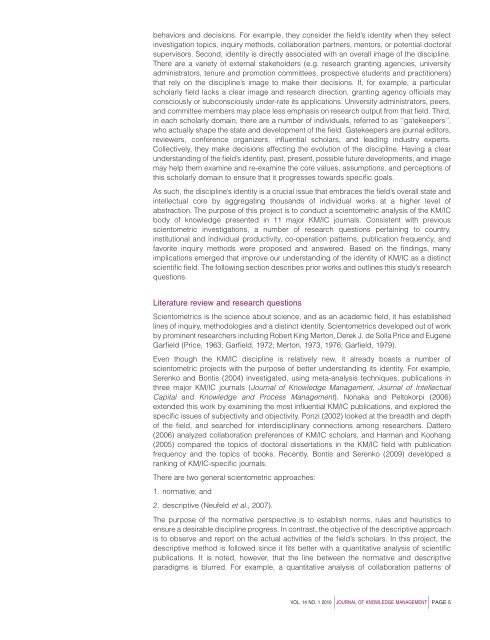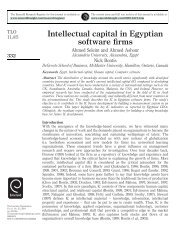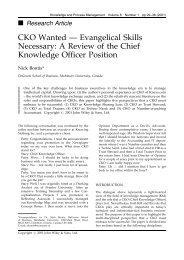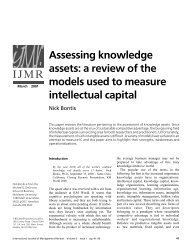A scientometric analysis of knowledge management and ... - Emerald
A scientometric analysis of knowledge management and ... - Emerald
A scientometric analysis of knowledge management and ... - Emerald
You also want an ePaper? Increase the reach of your titles
YUMPU automatically turns print PDFs into web optimized ePapers that Google loves.
ehaviors <strong>and</strong> decisions. For example, they consider the field’s identity when they select<br />
investigation topics, inquiry methods, collaboration partners, mentors, or potential doctoral<br />
supervisors. Second, identity is directly associated with an overall image <strong>of</strong> the discipline.<br />
There are a variety <strong>of</strong> external stakeholders (e.g. research granting agencies, university<br />
administrators, tenure <strong>and</strong> promotion committees, prospective students <strong>and</strong> practitioners)<br />
that rely on the discipline’s image to make their decisions. If, for example, a particular<br />
scholarly field lacks a clear image <strong>and</strong> research direction, granting agency <strong>of</strong>ficials may<br />
consciously or subconsciously under-rate its applications. University administrators, peers,<br />
<strong>and</strong> committee members may place less emphasis on research output from that field. Third,<br />
in each scholarly domain, there are a number <strong>of</strong> individuals, referred to as ‘‘gatekeepers’’,<br />
who actually shape the state <strong>and</strong> development <strong>of</strong> the field. Gatekeepers are journal editors,<br />
reviewers, conference organizers, influential scholars, <strong>and</strong> leading industry experts.<br />
Collectively, they make decisions affecting the evolution <strong>of</strong> the discipline. Having a clear<br />
underst<strong>and</strong>ing <strong>of</strong> the field’s identity, past, present, possible future developments, <strong>and</strong> image<br />
may help them examine <strong>and</strong> re-examine the core values, assumptions, <strong>and</strong> perceptions <strong>of</strong><br />
this scholarly domain to ensure that it progresses towards specific goals.<br />
As such, the discipline’s identity is a crucial issue that embraces the field’s overall state <strong>and</strong><br />
intellectual core by aggregating thous<strong>and</strong>s <strong>of</strong> individual works at a higher level <strong>of</strong><br />
abstraction. The purpose <strong>of</strong> this project is to conduct a <strong>scientometric</strong> <strong>analysis</strong> <strong>of</strong> the KM/IC<br />
body <strong>of</strong> <strong>knowledge</strong> presented in 11 major KM/IC journals. Consistent with previous<br />
<strong>scientometric</strong> investigations, a number <strong>of</strong> research questions pertaining to country,<br />
institutional <strong>and</strong> individual productivity, co-operation patterns, publication frequency, <strong>and</strong><br />
favorite inquiry methods were proposed <strong>and</strong> answered. Based on the findings, many<br />
implications emerged that improve our underst<strong>and</strong>ing <strong>of</strong> the identity <strong>of</strong> KM/IC as a distinct<br />
scientific field. The following section describes prior works <strong>and</strong> outlines this study’s research<br />
questions.<br />
Literature review <strong>and</strong> research questions<br />
Scientometrics is the science about science, <strong>and</strong> as an academic field, it has established<br />
lines <strong>of</strong> inquiry, methodologies <strong>and</strong> a distinct identity. Scientometrics developed out <strong>of</strong> work<br />
by prominent researchers including Robert King Merton, Derek J. de Solla Price <strong>and</strong> Eugene<br />
Garfield (Price, 1963; Garfield, 1972; Merton, 1973, 1976; Garfield, 1979).<br />
Even though the KM/IC discipline is relatively new, it already boasts a number <strong>of</strong><br />
<strong>scientometric</strong> projects with the purpose <strong>of</strong> better underst<strong>and</strong>ing its identity. For example,<br />
Serenko <strong>and</strong> Bontis (2004) investigated, using meta-<strong>analysis</strong> techniques, publications in<br />
three major KM/IC journals (Journal <strong>of</strong> Knowledge Management, Journal <strong>of</strong> Intellectual<br />
Capital <strong>and</strong> Knowledge <strong>and</strong> Process Management). Nonaka <strong>and</strong> Peltokorpi (2006)<br />
extended this work by examining the most influential KM/IC publications, <strong>and</strong> explored the<br />
specific issues <strong>of</strong> subjectivity <strong>and</strong> objectivity. Ponzi (2002) looked at the breadth <strong>and</strong> depth<br />
<strong>of</strong> the field, <strong>and</strong> searched for interdisciplinary connections among researchers. Dattero<br />
(2006) analyzed collaboration preferences <strong>of</strong> KM/IC scholars, <strong>and</strong> Harman <strong>and</strong> Koohang<br />
(2005) compared the topics <strong>of</strong> doctoral dissertations in the KM/IC field with publication<br />
frequency <strong>and</strong> the topics <strong>of</strong> books. Recently, Bontis <strong>and</strong> Serenko (2009) developed a<br />
ranking <strong>of</strong> KM/IC-specific journals.<br />
There are two general <strong>scientometric</strong> approaches:<br />
1. normative; <strong>and</strong><br />
2. descriptive (Neufeld et al., 2007).<br />
The purpose <strong>of</strong> the normative perspective is to establish norms, rules <strong>and</strong> heuristics to<br />
ensure a desirable discipline progress. In contrast, the objective <strong>of</strong> the descriptive approach<br />
is to observe <strong>and</strong> report on the actual activities <strong>of</strong> the field’s scholars. In this project, the<br />
descriptive method is followed since it fits better with a quantitative <strong>analysis</strong> <strong>of</strong> scientific<br />
publications. It is noted, however, that the line between the normative <strong>and</strong> descriptive<br />
paradigms is blurred. For example, a quantitative <strong>analysis</strong> <strong>of</strong> collaboration patterns <strong>of</strong><br />
VOL. 14 NO. 1 2010 j JOURNAL OF KNOWLEDGE MANAGEMENT j PAGE 5








